Seeing Rome was like a long interactive history lesson. Even if you are not fond of history, this is one history lesson that one should not miss.
We started out at the Coliseum keeping a wary look out for the gypsy thieves that we were warned against. There were a lot of English-speaking history students from various countries who had turned into part-time guides to help with the tuition, in addition to professional guides who offered guided tours of the Coliseum. We decided the tour may be worth it, even if it was just for the fact that we could avoid the long queue for the tickets. Tickets not withstanding, the tour was an excellent idea. For people like Seejo and me, whose knowledge of Roman history was limited to Julius Caesar, our tour guide was a mine of information.
 |
|
|
|
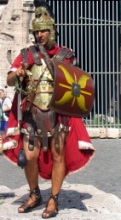 |
The Colloseum had a seating capacity of 50,000 people. The seats were allotted on the basis of social standing, gender and position. The Emperor, the Vestal Virgins and foreign visitors got the best seats in the house. The men sat in the lower seats closer to the arena while the women and the poor occupied the seats higher up around the ring. The Colosseum was witness to several duels between professional gladiators and fights between men and wild animals. Events at the Coliseum were a whole day affair begining with animal shows and comedy relief before moving on to the event of the day. Professional gladiators then fought against each other or wild half starved animals or trained slaves or condemned prisoners in front of a bloodthirsty crowd. The slaves and prisoners were not just randomly chosen. If a prisoner showed some talent or strength, he was chosen to duel against a gladiator. He would be trained and given the best of food to build up his strength, for a quick killing did not excite the public who were looking for a long and exciting fight. After the fight, it was the Emperor who would decide whether the loser would be killed or not. A good fighter, inspite of a lost fight was not always condemned to death. After all training a gladiator was an expensive investment. Sports, even back then, was a money making proposition. Reports also said that the Colisseum was the stage for several terrible injustices such as public rape of slave women, torture of Christians and a brutal treatment for prisoners.

Roman Forum: A Birds Eye View
From the Coliseum, we went on another guided tour, a free one this time, of the Roman Forum. The Forum is located over a large area and is strewn with the tombs and ruins of various structures from different Roman eras. If the Coliseum built in 80 AD seemed an ancient structure, then what could I say about the Roman Forum which was a thriving market place in 500 BC. It was the “downtown†for the ancient Romans. The Roman Forum though has structures from various centuries as Romans loved to build over existing structures. There are a lot of old buildings like the tomb of Julius Caesar, the temple of the Vestal Virgins, the Arch of Constantine, the Senate and so on. After an interesting recap of Roman History, we went up the Capitoline hill to get a breathtaking birds-eye view of the Forum. The museum on the hill houses a lot of objects and artifacts that were discovered from the ruins. These include household items, marble and bronze statues, and ancient tools and implements. We spent a short time looking at the vast collection and then made our way down to the main street.

The Victor Emmanuel Monument
We walked on towards the Piazza Venezia where we paused a moment to admire the huge white marble monument to King Victor Emmanuel II, the first King of unified Italy. This also serves as the tomb of the Unknown Soldier. On the other side was Trajan’s column, a huge white marble column to commemorate Roman King Trajan. We stopped a few minutes to look around, . then proceeded again.
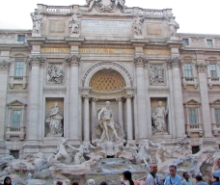
The Trevi Fountain
With guide maps in hand, we made our way to the Trevi Fountain. This was one of the several fountains that Bernini constructed across the city of Rome . But this one is supposed to bet he most magnificent of them all. It was certainly the most crowded place in Rome. Bangladeshi and Chinese street vendors were running all over the place trying to sell souvenirs. Seejo and I sat a little away, trying to appreciate the beautiful and the large sculptures that made up the fountain. There is a superstition that if you throw a coin into the Fountain and make a wish you will be able to come back to Rome .
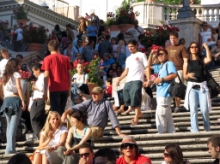
The Spanish Steps
The next day we visited Vatican City . On our way back we relaxed a bit near the very crowded Spanish Steps. The Spanish steps are actually a series of steps leading to a church. They were so crowded that we could hardly see any steps. In front of the steps is another of Bernini’s fountains. Two buildings away was the lodge of Lord Byron when he was in Rome .

The Pantheon
The next day we were up bright and early and made our way to the Pantheon. The Pantheon was a pagan Roman temple devoted to the worship of all gods (pan: all, theon: Gods). When Romans adopted Christianity, it was used as a church for some time, but the practice did not continue. The Pantheon has a very symmetrical construction. The Dome of the Pantheon was an architectural marvel in those days, a perfect hemisphere with the same radius at each point. At the center of the dome is a round skylight, the only source of light inside the Pantheon, in ancient times. There was a lot of effort and thought put into the construction of the then largest dome atop a structure. Pantheon is also the final resting place of one of the most famous Renaissance painters, Raphael. There were shrines in the walls of the Pantheon, some still having statues of saints. From the outside the Pantheon is not very impressive, its almost a shabby looking structure. But then the realization dawns that this building is almost 2000 years old and still very well preserved.
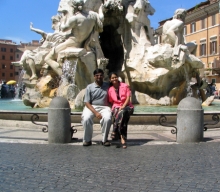
The Four Rivers Fountain
Next, we visited another famous fountain by Bernini at the Piazza Navona in the afternoon. This is the fountain of the 4 rivers. This is an almost bizarre architecture with 4 different old men representing 4 ancient rivers (The Nile, the Ganges, the Danube and the Plata each one representing the four different continents.) But apart from that , there is a plethora of animals and birds and trees around the base of the structure, even an armadillo! This grand structure forms the base of an obelisk , a Roman copy of an ancient Egyptian obelisk. Out of all the fountains of Bernini that we saw, this is the one that stays in my mind even now. Interestingly all the fountains have a common aqueduct system that runs throughout the city of Rome . The water is recycled between all the fountains. Also it is potable enough to drink!!!
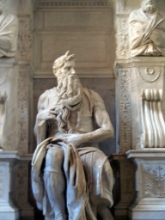
Michelangelo’s Moses
Our final stop in Rome was the Basilica of Sta. Maria Maggiore, near the coliseum. We spent some time admiring the Coliseum again from another angle and climbed the hill to enter the basilica. The highlight of the Basilica of Sta. Maria Maggiore was Michelangelo’s last work as a sculptor, the marble statue of Moses. This was originally intended as one of the side figures for the tomb of Pope Julius II. Seeing the height and the magnificence of this statue, I could only imagine how the tomb, if finished would have looked like. However, the tomb could not be completed and the statue found its final resting place in the Basilica of Sta. Maria Maggiore. The wrath in Moses’ face is palpable. He seems as though he is just about to rise from his marble chair. It was another example of Michelangelo’s skill as a sculptor. Every church in Rome has beautiful paintings, and magnificent ancient art. We spent a few moments admiring a few other paintings and then turned back to the station.
That was our last day in Rome. We were off to Pisa in a few hours.

